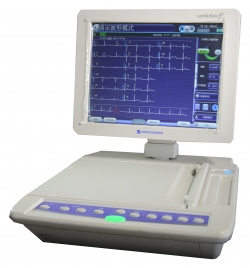Wechat QR code

TEL:400-654-1200

TEL:400-654-1200
By sequentially driving a red LED (660 nm) and an infrared LED (910 nm), the blue line indicates the induction curve of the receiver tube to the reduced hemoglobin when the hemoglobin is not an oxygen-containing molecule. From the graph, it can be seen that the reduced hemoglobin is 660 nm red. The absorption of light is relatively strong, and the absorption length of infrared light at 910 nm is relatively weak. The red line indicates the receiver tube-oxygenated hemoglobin sensing curve of hemoglobin with red oxygen molecules in the red blood cells. From the figure, it can be seen that the absorption of 660 nm red light is relatively weak, and the absorption of 910 nm infrared light is relatively strong. In the measurement of blood oxygen, the reduction of hemoglobin and aerobic haemoglobin, by detecting the difference between the two different wavelengths of light absorption, the measured data difference is the most basic measurement of blood oxygen saturation data. In the blood oxygen test, the two most common wavelengths of 660nm and 910nm actually achieve higher accuracy, and increase in addition to two wavelengths, even up to 8 wavelengths, the most important reason being that in addition to reducing hemoglobin, human hemoglobin In addition to oxyhemoglobin, there are other hemoglobins. We often see carboxyhemoglobin, and more wavelengths help you to do better.

For people
People with vascular disease (coronary heart disease, hypertension, hyperlipidemia, cerebral thrombosis........)
Vascular cavity has lipid deposition, blood is not smooth. Oxygen supply difficulties cardiovascular and cerebrovascular patients, blood viscosity, coupled with coronary arteriosclerosis, vascular stenosis, and thus poor blood supply, oxygen supply difficulties. Every day the body is "anoxic." Long-term mild hypoxia, heart, brain and other oxygen-consuming organ function will gradually decline. Severe hypoxia will lead to "infarction" and "cerebral stenosis." If you don't give oxygen in time, you will suffer sudden death. Therefore, long-term use of pulse oximetry in patients with cardiovascular and cerebrovascular blood oxygen content, can effectively prevent the occurrence of risk, if there is anoxic conditions, the first time oxygen, greatly reducing the chance of disease attack.
Monitor manufacturers
People with respiratory diseases (asthma. bronchitis, old chronic bronchitis, pulmonary heart disease, chronic obstructive pulmonary disease...)
Respiratory difficulties lead to limited oxygen intake. Oxygen detection in respiratory patients is indeed very important. On the one hand, difficulty in breathing can lead to insufficient oxygen intake. On the other hand, the persistence of asthma can also cause the tiny supporting organs to become blocked and allow gas exchange. Difficulty occurs, resulting in hypoxia, resulting in heart and lung. The brain and even the kidneys have different degrees of damage. Therefore, using a pulse oximeter to detect blood oxygen content, greatly reducing the incidence of respiratory tract.